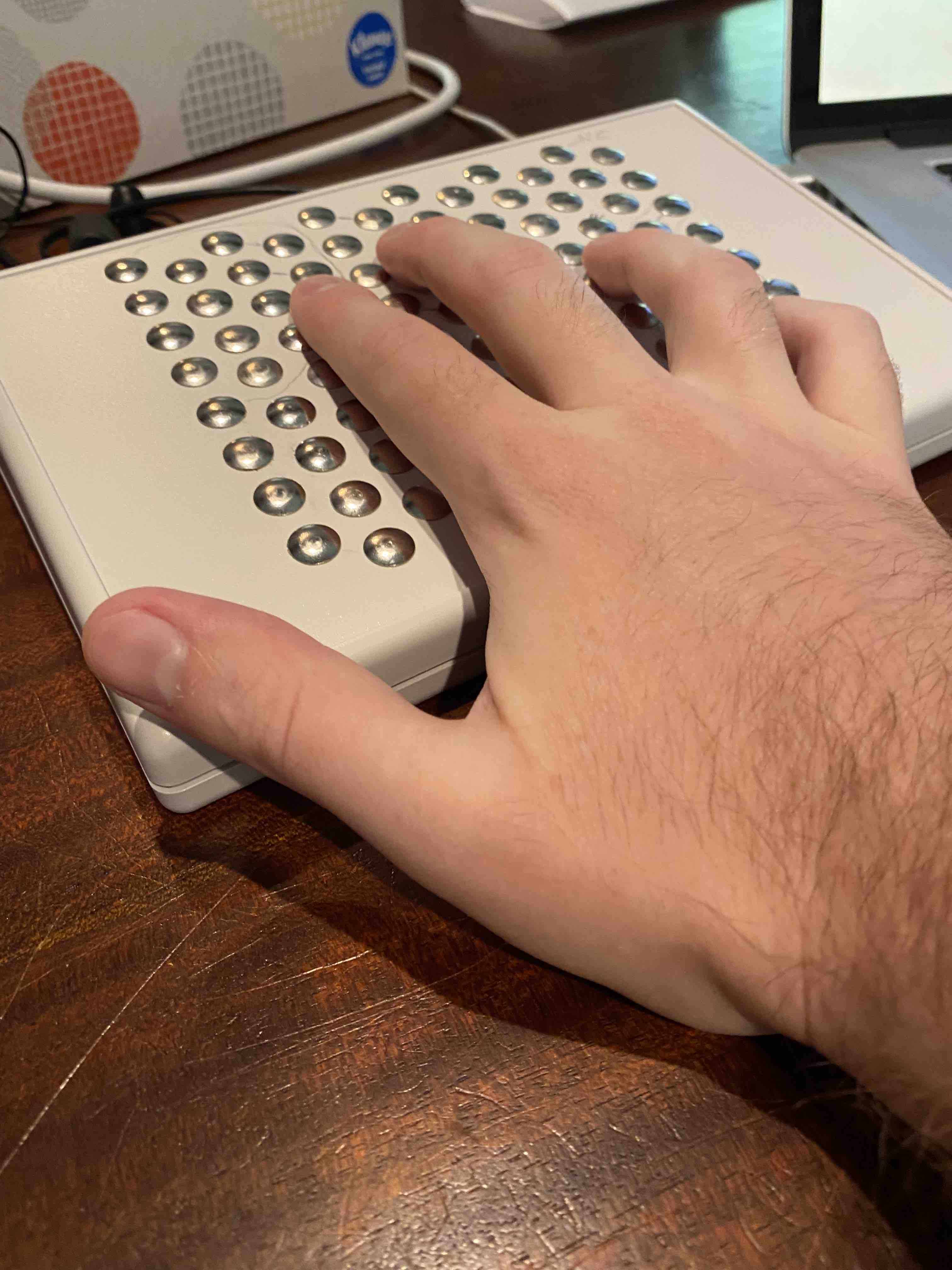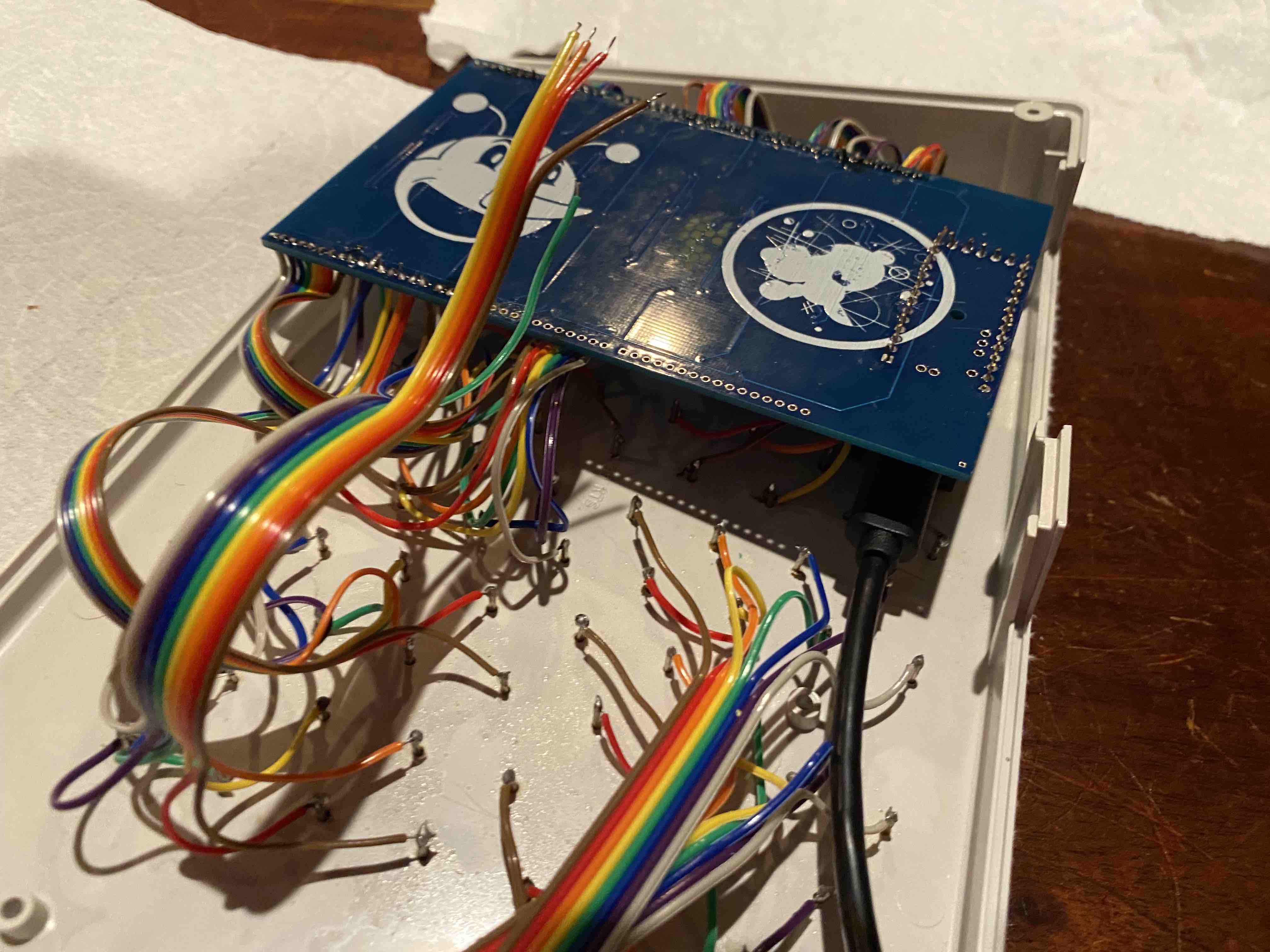BEE-N is an exploration into alternate keyboard layouts. The initial goal was a custom MIDI controller designed to mimic the layout of chromatic button accordions in a desk-oriented form factor. I quickly moved from that layout to lattice-based note arrangements, whose layouts offer beautiful and intuitive symmetries.
The specific placement of notes on the hexagonal grid I settled on places the major third, the perfect fifth, and the minor third adjacent to their root note, where the minor third is directly above the root note, and moving clockwise around the root we get the perfect fifth and then the major third. This arrangement means that the twelve notes of the chromatic scale are set up in this arrangement:

The electronic components I selected lent themselves nicely to a six-by-ten layout, so the note layout of the entire grid looks like this:
B1 A♯2 A3 G♯4 G5
D♯2 D3 C♯4 C5 B5
G♯1 G2 F♯3 F4 E5
C2 B2 A♯3 A4 G♯5
F1 E2 D♯3 D4 C♯5
A1 G♯2 G3 F♯4 F5
D1 C♯2 C3 B3 A♯4
F♯1 F2 E3 D♯4 D5
B0 A♯1 A2 G♯3 G4
D♯1 D2 C♯3 C4 B4
G♯0 G1 F♯2 F3 E4
C1 B1 A♯2 A3 G♯4
The selection of going up a minor third and going over a major third generates a fairly compact arrangement, so unlike using other choices of intervals (say, a perfect fourth and a major third), this controller can be played chromatically from lowest to highest note with a minimal duplicate notes.
At first glance, this arrangement might not seem particularly desirable. Though playing a major scale is both easy and symmetric, many common intervals, such as the second and the fourth, are far from the root and not in particularly memorable places. Where this layout absolutely shines is in chords and motions.
Any triangle of notes on this grid is either a major or minor triad in root position. Diminished and augmented chords are straight lines of three notes. Sevenths and ninths and other common variations are easily accessible, and inversions are easy to find. And because of the lattice structure, any chord shape is played the same way regardless of root note.

The motions available on this machine with this layout are fantastic and fascinating. Many common chord progressions are very simple. In both the twelve-bar blues and the I-V-vi-IV progressions, the chords are right next to each other, the motions are comfortable and intuitive.
The best part of experiencing this machine is that it does feel very much like a brand new instrument. Right after completing its construction and plugging it in, I had absolutely no idea how to begin. Just putting my fingers down and letting them scroll across the board made fascinating combinations of sounds. Natural hand shapes make new and pleasant chords. Above all else, the most enjoyable part of learning to play this machine is the process of making errors. Being off by a note now often results in something that feels more like a new variation rather than an error, misplacing my fingers has become something I occasionally try to remember and study. I barely understand this instrument at this point, and I already see so much potential in it.
The circuit is as uncomplicated as I could make it, and consists of a Teensy-LC and several analog multiplexers. The keys are standard (conductive) thumb tacks, connected to the Teensy's capacitive touch sensors. Before constructing this I was unsure whether capacitive touch was better for this use case than regular buttons or another type of input, but after even a short time playing on it I know that the tactility and ease of motions allowed is a very pleasant experience and quickly became something I have no interest in changing.
I had initially hoped that I could code these to be velocity-sensitive inputs, but so far I'm not sure the sensitivity is consistent enough to do that. I have yet to delve into the processor's documentation to see if there are ways to get more consistent readings. The capacitive touch pins also present sensitivity calibration concerns, but these can be easily handled in software, and I plan to add a calibration knob on future models for both a broader range of environments with different electrical characteristics and perhaps to play with ambient static electricity and other alternative methods of input.
In its current (first) iteration, it is a jumble of wires attached to the above circuit and housed on cardboard. Later iterations will likely have better housing, a proper circuit board, and likely MIDI control knobs or sliders. I also intend to make layout configuration more accessible on-the-fly, and I also imagine adding several buttons to manage various configurations without reprogramming.
After some playtesting, I suspect the second version will consist of a much tighter grid. While trying to learn some actual songs, I realised that while finger-triangle chords are lovely and fantastic, it would be even better to have triads you could play with a single finger. So, I plan to both tighten the grid and add more rows for greater range and ease of access. I am very excited to make the second version, though at the time I write this that will require thoroughly redesigning the PCB I've already spent some time on.
After some major redesigning, it is a complete device that works well, but with plenty of room to go. The most notable changes are that it now exists on its own PCB, and has a case to protect all the internals and make it portable and more usable. Additionally, the number of keys has expanded to eight by twelve (though the initial note relationships are the same).
Though the basic technical design remains mostly unchanged from the first version, I placed the keys closer together, which enables one to play the major and minor triads with a single finger. They are still far enough apart so that it can be played accurately.
The innards are a jumbled mess, but with patience and testing getting it together and nicely packaged isn't terribly difficult.
The only other critical flaw at this point (in my opinion) is that the latency is inconsistent and occasionally much higher than I feel it should be. To get around this, I've been redesigning the circuit completely and redesigning the firmware around it too. This new version uses different sensors and an interrupt-based design which should dwarf the latency and be much more consistent. Other than that and some simple quality-of-life changes, this is very close to being a finished product. It feels and plays great as is, once the newer version is worked out this will be excellent.
Demo video coming soon
The second version, completed


Pictures of the insides of the second version


Pictures of the first prototype, featuring loose wires on cardboard.


If you're interested in contacting me about this or anything feel free to send me an email at the address up top.